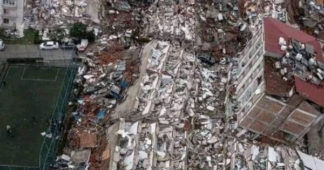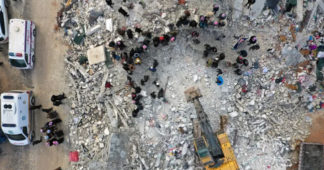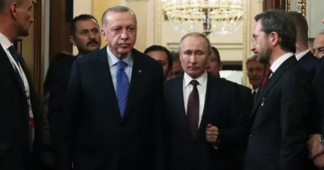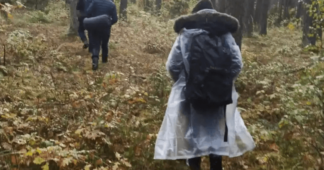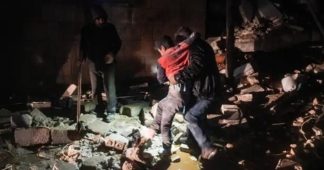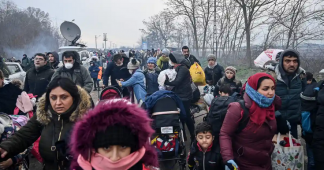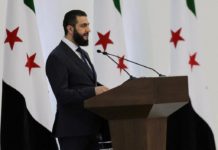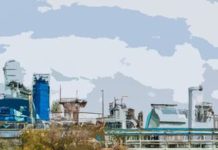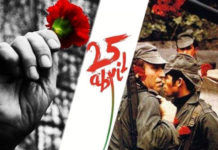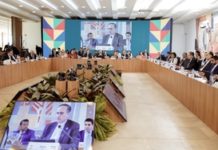February 07, 202
Magnitude 7.8 and 7.5 earthquakes struck Turkey near the Syrian border Monday, causing mass devastation in both countries. At least 5,000 casualties have been reported as of Tuesday morning, and rescue efforts are still underway. The WHO predicts that the final death toll could reach 25,000. The 7.8 earthquake, the largest recorded in Turkey since 1939, struck a region that has already been wracked by the Syrian civil war, compounding the existing humanitarian crisis in the region. Our guest is Evren Uzer, an associate professor of urban planning at The New School. After the İzmit earthquake of 1999, which killed more than 17,000 people in Turkey, Uzer worked to provide post-earthquake housing to survivors.
AMY GOODMAN: The World Health Organization is warning some 23 million people could be affected by the 7.8 and 7.5 earthquakes that struck southeastern Turkey and northern Syria on Monday, along with hundreds of aftershocks. The death toll from the earthquakes has risen to more than 5,000, expected to dramatically rise as search and rescue efforts intensify. More than 20,000 people have been injured. This is the strongest earthquake to hit Turkey since 1939, when 30,000 people died.
Turkish President Recep Tayyip Erdoğan has declared a three-month state of emergency. In a nationally televised speech, he said, quote, “We are face to face with one of the biggest disasters ever for our region,” unquote.
Thousands of buildings collapsed after the earthquakes, and more than 30 countries have joined the United Nations, Norwegian Refugee Council and others to help with rescue and recovery efforts, even as damaged buildings continue to fall, and thousands slept outdoors in the freezing temperatures. In Turkey’s border province of Hatay, residents anxiously searched for loved ones among the rubble.
CENNET INAL: [translated] Our relatives are dead. My sister’s daughter died. She was 17. My sister-in-law’s children are stranded under rubble. She’s there with three children. They are not rescued yet. God, please help us. Please pray for us. I beg you: Pray for us. Pray for us. There are aftershocks. It’s uncertain what will happen to us.
AMY GOODMAN: In Kahramanmaraş, Turkey, the epicenter of Monday’s deadly earthquake, 63-year-old Hulusi Ibrahim described being trapped under the rubble with his wife.
HULUSI IBRAHIM: [translated] I told myself this could be Doomsday. Without having a chance to think about what we could do, the building collapsed on us. I was with my wife. My wife was trapped under me. I didn’t hear from her for a very long time. When I finally managed to create a little bit of space for myself, I saw her lying unresponsive. I stayed with her for more or less three hours.
AMY GOODMAN: Families in Kahramanmaraş gathered around a bonfire in order to stay warm in the freezing weather. This is a local resident, Neşet Güler.
NEŞET GÜLER: [translated] We barely escaped from the inside house. We have four children, and we left the house with them at the last moment. I guess there are several people trapped inside. It was a huge disaster. Our situation is very bad here. We are waiting without water or food. We are in a miserable state.
AMY GOODMAN: Meanwhile, in Aleppo, Syrian survivors of the earthquake are helping rescue workers to clear the ruins of destroyed and damaged buildings, trying to break through cement to rescue other people.
SURVIVOR 1: [translated] We haven’t slept all night. We are really scared.
SURVIVOR 2: [translated] We are in the street. We do not have a place to go. There is either the mosque or the street.
REPORTER: [translated] Don’t you want to go home?
SURVIVOR 2: [translated] We’re scared for the children. When we went back home, a new earthquake took place, so we went back to the street. … We remember the days of the war, but this is God’s will.
AMY GOODMAN: The Syrian government in Damascus is only allowing aid to enter the region through one border crossing. The U.N. Office for the Coordination of Humanitarian Affairs says more than 4 million in northwest Syria where the deadly earthquake struck already rely on humanitarian assistance.
For more, we’re joined by Evren Uzer, associate professor of urban planning at The New School here in New York. She’s originally from Turkey, has been living and working there until 2010. After the İzmit earthquake of 1999, she worked to provide post-earthquake housing to survivors.
Welcome to Democracy Now! This horrific natural catastrophe, 7.8 magnitude and 7.5 magnitude earthquake on the Richter scale, talk about what you understand is the damage right now and what the people face.
EVREN UZER: Thank you, Amy.
It is really a grim situation right now in Turkey. The impact of the disaster is nothing compared to what we have experienced in the past. The main example was the 1939 earthquake, which was just one of these, and we have experienced two over 7 magnitude on Richter scale.
The area is quite wide. So, we are in a seismically active region, so earthquake preparedness is a part of the protocols of institutions. Students do drills, and so on and so forth. So it’s a part of culture, one can speak. And it, you know, happens even frequent enough to keep that in mind. But what happened here is that two earthquakes, one after the other, the impact area is more than 10 to 14 cities that has experienced collapses. So, everybody had to fend for themselves. And there has been — the access of the help from other cities have been interrupted and has been very slow due to the damage in the highways and airports.
Inside the cities also, we have been hearing a lot about critical infrastructure damages, like hospitals, which should be standing and providing service. So, lots of things happen at once right after an earthquake, that you need to provide shelter, safety for those who are out, and also there has to be very fast — and you’re racing with time here and hypothermia, because it’s been super cold in this area, around like 20 Fahrenheit degrees, with even cooler temperatures with the wind. So, those who are under the debris are also having shorter time. The first 24 hours has been very critical, and now we are going beyond there, as well. So, it is unfolding.
And as you have mentioned, even though the numbers are around 3,000 at the moment, we are expecting a much higher death toll in the area. Around 6,000 buildings have been confirmed demolished. Even with a simple calculation, we are talking about — with average four in every household, we are talking about 25,000 people at least in there. And the area, the southeastern region, has a higher household rate with more children and also elderly generational living.
JUAN GONZÁLEZ: And, Evren Uzer, in terms of — we saw these frightening pictures of some buildings completely collapsing within seconds, while a building next to them was still standing. What does that say about the building codes? Knowing that Turkey is prone to earthquakes and after the last big earthquake in 1999, what was done to ensure that buildings were able to withstand these types of earthquakes?
EVREN UZER: Thanks, Juan. So, 1999 earthquake has been a threshold, and the building codes had been updated, with another revision in 2018. And the process — whole process changed. So, there has been an auditing process to look for it. But what we see exactly in Marash and in epicenter Gaziantep, as well, we have seen new buildings collapsing, that are very recent, which tells certain things, that they might be up to code, but maybe the soil and ground analysis was not adequate, or the monitoring of the actual constructions has not been really up to date. So it tells a lot that there has been — the code and regulations has been up to date, but there are some other human errors. And that’s what it tells us in terms of construction quality.
JUAN GONZÁLEZ: And to what extent is the continuing conflict between the Turkish government and Kurdish rebels — what kind of effect will that have on the continuing rescue operations and, of course, in the rebuilding that must come afterward?
EVREN UZER: Well, the conflict and the current economic situation, there has been a lot of issues that made the region really not prepared for anything at this extent. So, we are talking about certain things. It’s not — this area has been a mixture. It’s international in many ways, that there has been Arabs and Kurds living in the area. There is a large number of Syrian refugees who have been gradually — from the camps, have been living in the cities. Gaziantep has like more than 20% of its residents are Syrian refugees. Before the conflict, there are other issues like language, like in the search and rescue operations.
And I think there has been — you know, these kind of disasters are, they say, equalizers, but they are not equalizers in the sense that those who are in more need prior to these earthquake will be in a more dire situation with less options. So, I would think that the existing conflicts, they will become more inflated, in the sense that it will slow the recovery, which is a very, very long road ahead of us, thinking from the 1999 recovery operations — and that has been in the western part of Turkey and with a lot of resources at their disposal, while the southeastern region lacks most of that infrastructure, in particular, that will require a lot of effort to rebuild.
AMY GOODMAN: Professor, the epicenter of the initial quake is Gaziantep in Turkey, as you mentioned, which houses hundreds of thousands of Syrian refugees. It’s where the UNHCR, the U.N. High Commissioner for Refugees, runs one of its largest operations. If you can talk about what this means for there? And also, over the border in Syria, it hit both the last rebel-held territory in Syria and the rest of Syria. And what kind of aid will get through by the Syrian government to the rebel-held area?
EVREN UZER: So, as you said, like, Gaziantep is holding more than 400,000 people — the city is around 2 million, and more than 20% is Syrian refugees who have been initially across the border and in camps and transitioned into bigger cities by the Turkish government starting from 2018. So they’ve been living in the city, mixed with the existing population of Gaziantep. So, there has been an increase in the past years. That means new construction of buildings, as well, to accommodate all the newcomers. There has been already certain conflicts because of the sudden change of — like, drastic change of demographics in the area.
For now, the main cities still received a lot of resources and supports, while that are more closer to border — Hatay, for instance — had struggled much more, which also is hosting one of the temporary — still temporary camps of refugees around there. So, we can say the resources will be harder to reach. And for the Syrian border, there was only one allowed border crossing, which is currently not accessible. So that means, on the Syrian side of the border, the situation is even harder in terms of access search and rescue tools, because you really need large construction machinery to work with the rubble, and also lots of manpower. Even though there are like around 16,000, 18,000 national and international rescue teams working in the area, it is not enough, thinking of the extent of the damage. This is really out of scale, thinking of the whole New York state totally leveled, and we cannot communicate with one another and to understand the extent of the damage. We are talking about a really large-scale catastrophe.
JUAN GONZÁLEZ: And from your experience with the 1999 earthquake, what’s been the ability of the Turkish government officials to respond to a catastrophe of this type, to build new housing for those who are displaced, especially in light of the fact that there’s supposed to be national elections in just a few months in Turkey? What’s your sense of the government’s capacity and what international — what other countries can do to help the Turkish people?
EVREN UZER: So, as I said, this is a long run. I mean, there are immediate things that needs to be done right now, which is all around search and rescue and providing the basic needs for the ones who are rescued. But we are talking about temporary/permanent housing that will go years in recover, and probably replacement, as well. Some of these areas cannot be resettled, so there need to be relocations maybe discussed. So we’re talking about a large-scale work which will require a lot of aid that needs to come in and used in a way that will help people with the least destruction to their livelihoods and communities.
The government has a lot of capacity, in the sense that after 1999, that we have been having a special earthquake tax. And we have been prepared in the sense that, as I mentioned, building codes and so on. So there is a lot of preparation. In terms of mobilizing, I think this extent was not something — the local government was not as prepared. And we see a lot of decisions are much more centralized since we last experienced this. There has been a slowness in deploying the search and rescue teams or for teams to arrive from different places to go and find healthy information about where is the highest need.
The ’99 election — 1999 earthquake was also followed by elections in early 2000, which the current ruling party, AK Party, has come to power based on the work and the promises that they came with the earthquake preparation and risk reduction, in general. So, it is very crucial. And as I said, this is such a paralyzing moment for every part, that it’s been not clear how the response will unfold, but so far it has been quite slow, and they might have an impact on the elections.
AMY GOODMAN: Every minute makes a difference right now, still in the recovery phase, families living in all these buildings, people living — they were asleep. It was around 4:00 in the morning. But still people can survive if aid gets to them. Professor Uzer, how would you like the media to cover this enormous tragedy? What’s missing from the coverage you’ve seen so far? And how can people help?
EVREN UZER: Thank you so much for asking that. There is a lot of misinformation going around, former footages, and it is hard to get healthy information. There are some groups that are working online right now to create real data, for instance, on mapping the rural, which we didn’t even come to that, unfortunately. We are talking about bigger cities. But the rural areas, hard-to-access areas, are not necessarily — we don’t have an updated information. So there are groups that are crowdsourcing information. And there are groups like Teyit.org that are working on clear information, traffic and for those who are still under the debris who could reach with their phones and so on.
There are international, particularly from listeners from the U.S., that there are ways to support the local organizations that are working in the area. There is Bridge to Türkiye and Turkish Philanthropy Fund, for instance, two of these organizations that have direct access to local networks, like Ahbap and AKUT, search and rescue and fast relief operations. So, one way to support Turkish people trying to really save their loved ones and at the same time survive, those will be one of those options.
AMY GOODMAN: Well, Evren Uzer, we thank you so much for being with us, associate professor of urban planning at The New School here in New York, originally from Turkey, living and working there until 2010. After the İzmit earthquake of 1999, she worked to provide post-earthquake housing to survivors.
We remind our readers that publication of articles on our site does not mean that we agree with what is written. Our policy is to publish anything which we consider of interest, so as to assist our readers in forming their opinions. Sometimes we even publish articles with which we totally disagree, since we believe it is important for our readers to be informed on as wide a spectrum of views as possible.
